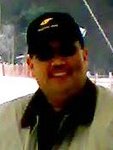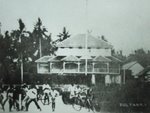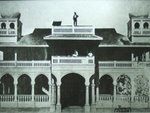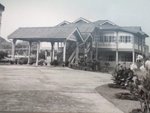 [Photo: Prophet Muhammad S.A.W. house in Mekah before it was demolished.]
[Photo: Prophet Muhammad S.A.W. house in Mekah before it was demolished.]In his book Akhbar Makkah, Vol. 2, p. 160, the 3rd-century historian of Makkah, al-Azraqi, mentions as one of the many places in Makkah in which the performance of salat is desirable (mustahabb), the house where the Prophet was born (Mawlid an-Nabi). According to him, the house had previously been turned into a mosque by the mother of the caliphs Musa al-Hadi and Harun ar-Rashid.
The Qur'anic scholar al-Naqqash (266-351) mentions the birthplace of the Prophet as a place where du`a by noon on Mondays is answered. He is quoted in al-Fasi's Shifa' al-gharam Vol. 1, p. 199, and others.
Earliest Mentions of the Public Mawlid
The oldest source that mentions a public commemoration of the Mawlid is in Ibn Jubayr's (540-614) Rihal ("Travels"), p. 114-115:
"This blessed place [the house of the Prophet] is opened, and all men enter it to derive blessing from it (mutabarrikin bihi), on every Monday of the month of Rabi` al-Awwal; for on that day and in that month was born the Prophet."
The 7th-century historians Abul `Abbas al-`Azafi and his son Abul Qasim al-`Azafi wrote in their unpublished Kitab ad-durr al-munazzam:
"Pious pilgrims and prominent travellers testified that, on the day of the mawlid in Makkah, no activities are undertaken, and nothing is sold or bought, except by the people who are busy visiting his noble birthplace, and rush to it. On this day the Ka`ba is opened and visited."
Three Tenth-Century Accounts of the Mawlid
The following description consolidates eyewitness accounts by three 10th-century authorities: the historian Ibn Zahira al-Hanafi from his al-Jami` al-latif fi fasl Makka wa ahliha, p. 326; Imam Ibn Hajar al-Haytami from his Kitab al-mawlid al-sharif al-mu`azzam, and the historian al-Nahrawali from al-I`lam bi-a`lam bayt Allah al-haram, p. 205.
Each year on the 12th of Rabi` al-Awwal, after the salat al-Maghrib, the four qadis of Makkah (representing the Four Schools) and large groups of people including the fuqaha' (scholars) and fudala' (notables) of Makkah, shaykhs, zawiya teachers and their students, ru'asa' (magistrates), and muta`ammamin (scholars) leave the mosque and set out collectively for a visit to the birthplace of the Prophet, shouting out dhikr and tahlil (LA ILAHA ILLALLAH). The houses on the route are illuminated with numerous lanterns and large candles, and a great many people are out and about. They all wear special clothes and they take their children with them. Having reached the birthplace, inside a special sermon for the occasion of the birthday of the Prophet is delivered, mentioning the miracles (karamat) that took place on that occasion. Hereafter the du`a' for the Sultan (i.e. the Caliph), the Emir of Makkah, and the Shafi`i qadi is performed and all pray humbly. Shortly before the salat al-`Isha', the whole party returns from the birthplace of the Prophet to the Great Mosque, which is almost overcrowded, and all sit down in rows at the foot of the Maqam Ibrahim. In the mosque, a preacher first mentions the tahmid (AL HAMDULILLAH) and the tahlil, and once again the du`a' for the Sultan, the Emir, and the Shafi`i qadi is performed. After this the call for the Salat al-`Isha' is made. After the salat, the crowd breaks up. A similar description is given by al-Diyarbakri (d. 960) in his Ta'rikh al-Khamis.
source: http://www.sunnah.org/arabic/mawldhouse/history_of_the_mawlid_house.htm







No comments:
Post a Comment